Verticordia harveyi, commonly known as autumn featherflower, is a flowering plant in the myrtle family, Myrtaceae and is endemic to the south-west of Western Australia. It is a slender, spindly shrub with relatively long leaves and small white, pink or magenta-coloured flowers in late summer and autumn.

Verticordia helichrysantha, commonly known as coast featherflower or Barrens featherflower, is a flowering plant in the myrtle family, Myrtaceae and is endemic to the south-west of Western Australia. It is a small, woody, open-branched shrub with crowded, linear leaves and small yellow flowers from May to September.

Hibbertia hypericoides, commonly known as yellow buttercups, is a species of flowering plant in the family Dilleniaceae and is endemic to the south-west of Western Australia. It is usually a spreading shrub with linear to elliptic or egg-shaped leaves, and yellow flowers, usually with ten to fifteen stamens arranged in a cluster on one side of the two densely hairy carpels.

Guichenotia ledifolia is a species of flowering plant in the family Malvaceae and is endemic to the southwest of Western Australia. It is a densely-branched shrub with densely hairy new growth, hairy, linear to oblong leaves and pink to mauve flowers arranged in groups of three to ten.

Verticordia humilis, commonly known as small featherflower, is a flowering plant in the myrtle family, Myrtaceae and is endemic to the south-west of Western Australia. It is a small shrub with leafy branches and scattered, mostly red flowers hanging loosely near the ends of the branches.
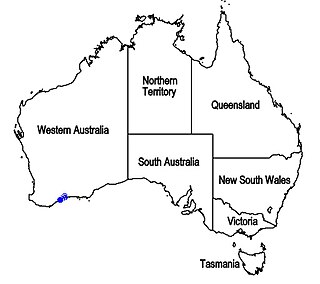
Hemiphora exserta is a flowering plant in the mint family Lamiaceae and is endemic to the south-west of Western Australia. It is a sprawling shrub with its branches densely covered with white, woolly hairs. Its leaves are rough and wrinkled and the flowers are deep pink or dark red, curved and tube-shaped with spreading petal lobes on the end.
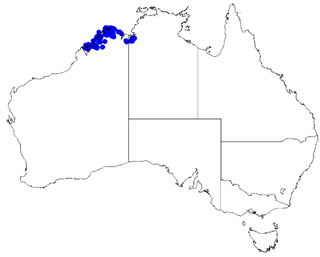
Boronia wilsonii is an erect shrub that is endemic to northern Australia. Its branches, leaves and backs of the flowers are densely covered with woolly hairs. The petals are white to pink or burgundy-coloured.
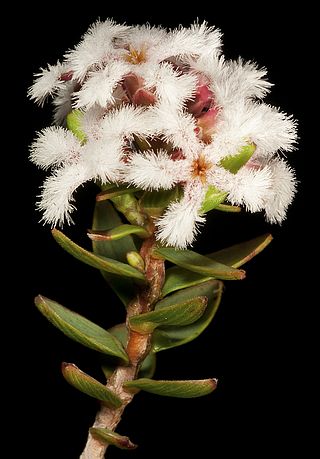
Leucopogon polymorphus is a species of flowering plant in the heath family Ericaceae and is endemic to near-coastal areas of south-western Western Australia. It is a shrub with egg-shaped to lance-shaped or almost linear leaves and short, dense spines of white, tube-shaped flowers.
Dillwynia divaricata is a species of flowering plant in the family Fabaceae and is endemic to the south-west of Western Australia. It is an erect, spindly shrub with cylindrical, grooved leaves and yellow flowers with brownish markings.

Lechenaultia acutiloba, commonly known as wingless leschenaultia, is a species of flowering plant in the family Goodeniaceae and is endemic to the south-west of Western Australia. It is a dome-shaped shrub with crowded, linear leaves and many tube-shaped, pale greenish-yellow flowers with blue tips.

Lasiopetalum rosmarinifolium is a species of flowering plant in the family Malvaceae and is endemic to the south-west of Western Australia. It is an erect or spreading shrub with hairy stems and leaves, linear leaves and white flowers.
Stenanthemum divaricatum is a species of flowering plant in the family Rhamnaceae and is endemic to the southwest of Western Australia. It is a small, often spiny shrub with sparsely hairy young stems, fan-shaped to narrowly egg-shaped leaves and densely, softly-hairy heads of tube-shaped flowers.
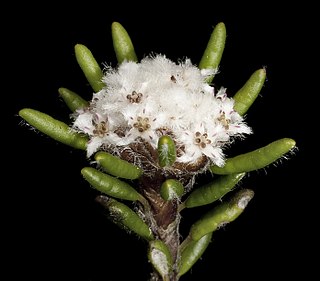
Stenanthemum humile is a species of flowering plant in the family Rhamnaceae and is endemic to the southwest of Western Australia. It is a low, erect perennial herb or shrub with white, woolly-hairy young stems, linear to narrowly elliptic leaves and densely, woolly-hairy heads of tube-shaped flowers.

Leucopogon lasiophyllus is a species of flowering plant in the heath family Ericaceae and is endemic to the south-west of Western Australia. It is an erect shrub with linear to lance-shaped leaves and small, dense spikes of tube-shaped white flowers on the ends of branches and in leaf axils.

Leucopogon lasiostachyus is a species of flowering plant in the heath family Ericaceae and is endemic to the south-west of Western Australia. It is an erect shrub with egg-shaped to lance-shaped leaves and dense, cylindrical spikes of tube-shaped white flowers on the ends of branches and in leaf axils.
Guichenotia anota is a flowering plant in the family Malvaceae and is endemic to a restricted part of the southwest of Western Australia. It is a low, erect, compact shrub with hairy new growth, oblong to narrowly egg-shaped leaves, and pinkish-purple flowers.
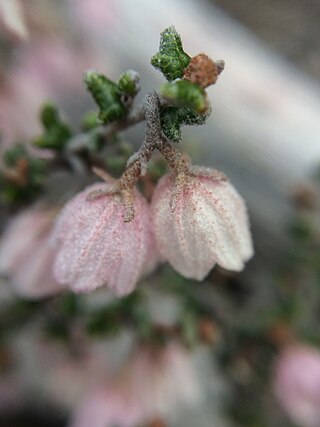
Guichenotia apetala is a flowering plant in the family Malvaceae and is endemic to a small area in the southwest of Western Australia. It is a small, erect, compact shrub with many branches, densely hairy new growth, triangular to heart-shaped leaves, and salmon pink flowers.
Guichenotia astropletha is a flowering plant in the family Malvaceae and is endemic to the southwest of Western Australia. It is a dwarf, spreading shrub with hairy new growth, linear to narrowly egg-shaped leaves, and pink flowers.

Guichenotia micrantha, commonly known as small flowered guichenotia, is a species of flowering plant in the family Malvaceae and is endemic to the south-west of Western Australia. It is a low, compact shrub with linear to narrowly egg-shaped leaves and pink flowers in groups of three to six.
Guichenotia quasicalva is a species of flowering plant in the family Malvaceae and is endemic to the south-west of Western Australia. It is a low, spindly shrub with narrowly egg-shaped to linear leaves and pink flowers in groups of two to four.














